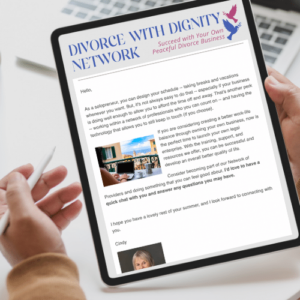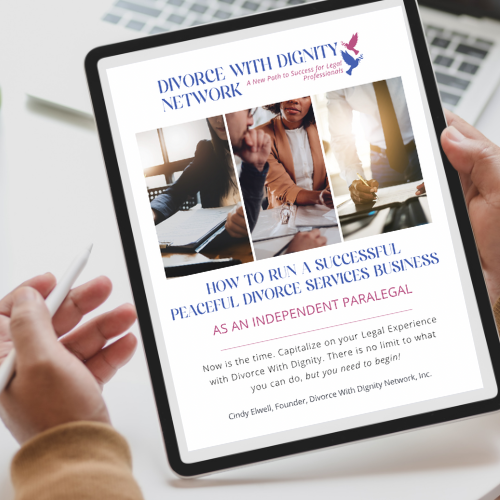A Profession at a Crossroads
The divorce and family law profession is in the middle of a profound shift. Ask almost any mediator, paralegal, attorney, or divorce coach today, and you’ll hear similar themes: it’s harder than ever to attract and retain clients, the emotional demands of adversarial work are exhausting, and traditional business models no longer feel sustainable.
At the same time, families are facing their own intense pressures. Rising debt, economic uncertainty, and global instability have made it harder for couples to imagine a clear way forward when their marriages end. Many want to avoid the financial and emotional toll of litigation, but they aren’t sure where to turn.
These realities are pushing both families and professionals toward a new path—one that prioritizes dignity, affordability, and sustainability over fighting it out in court.
The Economic Realities You Can’t Ignore
Money has always played a role in divorce, but in today’s climate, it often dominates the decision-making process. Families who might have paid hefty retainers in the past are now pausing or abandoning litigation altogether because it simply isn’t financially feasible.
For professionals, this creates a domino effect. Billable hours are harder to secure. Collection times stretch longer. And even when clients do move forward, the work often doesn’t justify the financial return.
Consider that a fully litigated divorce in the U.S. can cost anywhere from $15,000 to $30,000 per person. For families already managing mortgages, student loans, and childcare costs, these numbers feel impossible.
Professionals who adapt to this reality by offering peaceful, non-litigation options are finding that clients are not only more willing to move forward, but also more grateful for solutions that don’t put them deeper into debt.
The Emotional Toll of Adversarial Work
Finances aren’t the only source of strain. For many professionals, the work itself has become emotionally unsustainable.
Litigation is, by nature, adversarial. Attorneys spend long days preparing to fight. Paralegals spend hours chasing documents and filings. Even mediators, who often try to bridge the gap, can find themselves pulled into the conflict dynamic.
Over time, this constant exposure to conflict can lead to burnout—a feeling of exhaustion, cynicism, and reduced effectiveness. Many professionals quietly admit that the work no longer feels like “helping.” Some leave the field entirely.
And the impact extends beyond professionals. Families who endure contentious litigation often emerge more fractured than they began. Parents struggle to co-parent effectively, children absorb the stress, and what could have been a transition becomes a trauma.
It’s little wonder so many professionals are asking themselves: Is there a better way to do this work?
Shifts in Client Demand
The answer lies, in part, in listening to what clients want. Increasingly, families are seeking alternatives that prioritize stability over combat.
-
Affordability: Clients want flat fees, predictable costs, and solutions that won’t bankrupt them.
-
Time: Families want to move forward quickly, without months of litigation delays.
-
Mental health: Parents and children alike are seeking less traumatic experiences. Post-pandemic, awareness of emotional well-being is at an all-time high.
-
Stability for children: Parents are beginning to recognize that “50/50” isn’t always what kids need most. Stability and consistency often matter more.
Professionals who can deliver on these priorities are not just meeting demand—they’re positioning themselves as leaders in a field that is rapidly evolving.
What Peaceful Divorce Practices Offer Professionals
For professionals who have embraced peaceful divorce practices, the benefits are both practical and personal.
-
Alignment with values: Many entered the field to help people, but adversarial systems made that difficult. Peaceful practices restore a sense of purpose.
-
Predictable income: Fee structures that are flat, bundled, or subscription-based provide more stability than chasing billable hours.
-
Reduced burnout: Without daily courtroom drama, professionals often rediscover energy for both their work and their personal lives.
-
Expanded skills: Mediation, coaching, co-parenting agreements, and document preparation broaden their toolkit.
-
Support and community: Many join networks or collaboratives that provide training, marketing help, and peer connection.
This shift doesn’t mean abandoning professionalism or rigor. It means applying those skills in ways that are sustainable—for both professionals and the families they serve.
Stories of Change
The most powerful evidence comes from professionals who have already made the transition.
-
The former litigator: After 20 years of courtroom battles, one attorney realized “winning” cases no longer felt like success. She transitioned into peaceful divorce services, and today she measures success by how stable and cooperative her clients feel at the end of the process. Her income is steady, but even more importantly, her stress is dramatically reduced.
-
The paralegal turned provider: After years of being underpaid and overworked, one paralegal used her knowledge of forms and filings to start her own practice focused on mediation support and document preparation. Within 12 months, she had built a caseload of her own—and with it, a sense of pride and professional independence.
-
The divorce coach: What began as leading small support groups eventually grew into a full-fledged practice guiding families through co-parenting transitions. She no longer feels like an “adjunct” to the process; she’s central to helping families design healthy futures.
These stories are not anomalies. They reflect a growing trend: professionals are choosing peaceful divorce practices not just because they work for clients, but because they work for them.
The Future of Divorce Practice
All signs point in one direction: peaceful divorce is not a niche trend—it’s the future of the field.
For families, the benefits are undeniable: lower costs, less trauma, greater stability.
For professionals, the payoff is equally compelling: alignment with values, financial sustainability, and healthier work-life balance.
The profession is at a turning point. Those who adapt to these cultural and economic shifts are not only more likely to thrive, but also to shape a healthier model for the generations ahead.
A Resource for Reflection
If you’re a professional reflecting on your own path, now is a good time to ask: Does my current practice align with where the field—and my values—are heading?
For those who want to explore what it looks like to build a sustainable, peaceful divorce practice, we’ve created a resource guide with more details. You can download it here: Provider Guide link.





